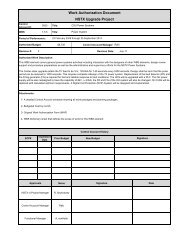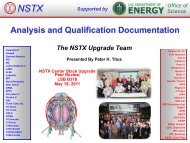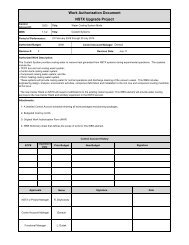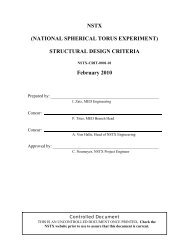Steve Langish 11 January 2012 - PPPL EVMS Page
Steve Langish 11 January 2012 - PPPL EVMS Page
Steve Langish 11 January 2012 - PPPL EVMS Page
Create successful ePaper yourself
Turn your PDF publications into a flip-book with our unique Google optimized e-Paper software.
<strong>Steve</strong> <strong>Langish</strong><strong>11</strong> <strong>January</strong> <strong>2012</strong>1
http://science.energy.gov/opa/projectmanagement/evms-certifications/2
• It is recommended dd that further training i on EAC analysis andmaintenance be conducted with the CAMs, and the CAMsshould take on a more active role in maintaining their EAC.The training should include the value a properly maintainedEAC adds to the project, as well as how to determine whatjustifies an EAC update. It is also recommended thatdocumentation be kept on file to reflect the basis of theadjustment, and that both additions and subtractions bemaintained i in the EAC in order to reflect a valid projection ofproject costs.3
• The Committee recommends that t <strong>PPPL</strong> deploy <strong>EVMS</strong> training i that t isconsistently and rigorously applied so that the message becomes a partof the normal work process of functioning as a CAM or a PCM. A trainingvenue, especially in the areas of change control, EAC and thedevelopment and usage of a comprehensive Control Account Plan shoulddeliver results that show CAMs and PCMs have integrated the teachinginto their everyday work methods and not just ‘taken’ a class or reviewedan online assignment; then “went back to work”. The intent of theCommittee’s recommendation is not so much to request training is“conducted” but that a training program is focused on the CAMs andPCMs “using” the training and ensuring the consistent and continuousapplication of the <strong>EVMS</strong> policies and procedures across all ControlAccounts.4
• Change Control (ECPs)• Requirements• Discussion of Change Control (NSTXU‐PROC‐001)NSTXU Configuration Control• On‐line ECP Process• Estimate at Complete• Requirements……..and what feedback is needed• Calculations• Control Account Plan• Requirements• Components5
• ANSI‐748/NDIA Intent Guide for Revisions and DataMaintenance• Guideline #28: Incorporate authorized changes in a timely manner, recording theeffects of such changes in the budgets and schedules. In the directed effort prior tonegotiation of a change, base such revisions on the amount estimated andbudgeted to the program organizations.• Guideline #29: Reconcile current budgets to prior budgets in terms of changes tothe authorized work and internal re‐planning in the detail needed by managementfor effective control.• Guideline #30: Control retroactive changes to records pertaining to workperformed that would change previously reported amounts for actual costs,earned value, or budgets. Adjustments should be made only for correction oferrors, routine accounting adjustments, effects of customer or managementdirected changes, or to improve the baseline integrity and accuracy ofperformance measurement data.• Guideline #31: Prevent revisions to the program budget except for authorizedchanges.• Guideline #32: Document changes to the performance measurement baseline.6
• PMSD Section 5 Change Control• PMSD Procedure 9 Change Control• When a <strong>PPPL</strong> CAM observes or is presented with apotential scope, schedule, or budget change the CAMwill notify the Project Manager. The CAM works withProject Controls to define the impacts of theproposed change. The CAM then submits a change,using an ECP form, to the Project Manager. ProjectControls maintains the project ECP Log generates anECP number and summarizes the schedule and/orbudget impact of the proposed change.7
• Applicability:• This procedure covers changes to the followingcontrolled documents that define the functional ortechnical requirements, the design configuration ofthe NSTX Upgrade Project (NSTXU), or cost andschedule baselines associated with the technicalbaseline:▪ Approved NSTXU specifications, including the GeneralRequirements Document (GRD) and System RequirementsDocuments (SRDs);▪ Approved Interface Control Documents (ICDs); and▪ NSTXU cost and schedule baselines.9
When ECP NeededWhen there is a design change that impacts a Specification(Technical Baseline Requirements) or the Cost or Schedulebaselines. Drawing changes (technical baseline) will also impact aSpecification since the Specification contains a table that lists thelatest drawing revisions.Minor editorial changeswill not normally requirethe processing of an ECP.The Systems EngineeringiManager will determinewhether an ECP isrequired on a case‐by‐case basis.Additionally, an ECP may be used to request application ofcontingency in cases where:1. There is a directed change from DOE in the annual funding or schedule;or2. There is a change in the GRD impacting scope and schedule; or3. There is a change in the PEP that reflects a change in a Level 1 or Level 2milestone or redefines dfi PEP deliverables; or4. A planned procurement bid is much higher or reflects a significantschedule change; or5. Experience has shown that certain estimated work is more complex andwill require application of contingency to reflect added complexity y( (NOTA RETROACTVE CHANGE).When ECP NOT Needed10
http://198.35.0.12/fmi/iwp/res/iwp_home.html12
• Guideline #27: Develop revised estimates ofcost at completion based on performance todate, commitment values for material, andestimates of future conditions. Compare thisinformation with the performancemeasurement baseline to identify variancesat completion important to companymanagement and any applicable customerreporting requirements including statementsof funding requirements.13
• On a monthly basis, the control account manager shouldreview the status of the expended effort and theachievability of the forecast and significant changes briefedto program management. This analysis should ldfocus onperformance to date within the control account, anassessment of the effort to complete the remaining work,and an evaluation of the type and quantity of resourcesrequired to complete the effort. When updates are made toexisting forecasts of cost to complete, significant changesare briefed to program management. Prudent maintenanceof the control account‐level EAC by the control accountmanager ensures that the EAC reflects a valid ldprojection ofproject costs.14
• (From the PMSD) On a Monthly basis the CAMSHALL:• Review the Estimate to Complete (ETC) for theelements of their control account. If, in the judgmentof the CAM, the current ETC does not accuratelyreflect the cost for the remaining i work in the controlaccount, the CAM develops a new estimate andsubmits it to the Project Manager. CAMs shouldinclude in the ETC any cost variances to date as wellas estimates for known pending changes andmitigation of known risks.15
• Provided EACH MONTH by the CAM• NSTXU PEP requires a bottom‐up estimateevery six monthsEAC Updates DO NOTCHANGE YOUR BUDGET !You must file an ECP to changeyour budget!!TAB <strong>11</strong> of CAM Notebook16
MY EAC IS = MUSTSUPPLY A NUMBER EACHMONTH – MUST ADDCURRENT MO. COST VAR.17
• There Are Many Formulas That Can Be Used ToCalculate The EAC• EAC = ACWP + ETC▪ Used Early On In Project Execution▪ Uses Actuals & Subjective Estimate To Complete Provided By CAMs• EAC = ACWP/BCWP x BAC▪ Assumes That The Burn‐rate Will Be The Same For The RemainderOf The Project▪ Uses The Actuals, Performance & The BAC• EAC = BAC/CPI▪ Assumes That The Burn‐rate Will Be The Same For The RemainderOf The Project▪ Uses BAC & CPI Instead Of Actuals• I Can Keep Going But Let’s Just Get To The Punch Line…18
• Procedure 5 of PMSD “Control Account Plan/Work Authorization”• Upon direction of the PM, the CAM develops scope, detailedschedules and resource/cost estimates for his/her assigned WorkPackages and Planning Packages (WAF). The CAMs forward these costestimates to Project Controls for validation ld using the Control AccountPlan (CAP)/Work Authorization form for each control account. TheCAP includes the relationship to the WBS element or elements,responsible organization identification, control account taskdescription, schedule, hdl and time‐phased dbudget in dollars. The ControlAccount Plan/Work Authorization is reviewed by the Project Controlsmanager and approved by the Project Manager and the CAM todocument the delegation of work to the CAM. Work Packages areauthorized to begin upon signature of the PM and the CAM. All workscheduled to start in a current month shall have a detailed plan for theapplicable work package. Completed and signed Work Packages shallbe in place before beginning work.20
• Tab 2 of CAM Notebook• Work Authorization Document (WAD)• Schedule showing all WPs and PPs• Budgeted cost by month• Original WAF• WBS Dictionary sheet that defines the scope ofwork for this WBS element21
• Take Away’s:• On‐line system set up for CAMs to submit ECPs• Monthly EAC updates are required by all CAMs. A monthlyEAC has been started to document.• Bottom‐up estimate due at end of month• EAC updates DO NOT change your budget• Control Account Plans consist of WADs and attacheddocumentation:▪ Primavera Schedule▪ Original signed WAF▪ Applicable portion of the WBS Dictionary (from PEP)▪ Monthly allocated budget24








